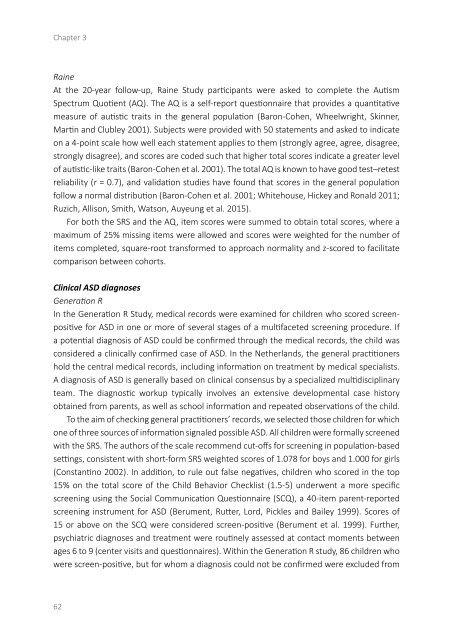On the Spectrum
2lm5UyR
2lm5UyR
You also want an ePaper? Increase the reach of your titles
YUMPU automatically turns print PDFs into web optimized ePapers that Google loves.
Chapter 3<br />
Raine<br />
At <strong>the</strong> 20-year follow-up, Raine Study participants were asked to complete <strong>the</strong> Autism<br />
<strong>Spectrum</strong> Quotient (AQ). The AQ is a self-report questionnaire that provides a quantitative<br />
measure of autistic traits in <strong>the</strong> general population (Baron-Cohen, Wheelwright, Skinner,<br />
Martin and Clubley 2001). Subjects were provided with 50 statements and asked to indicate<br />
on a 4-point scale how well each statement applies to <strong>the</strong>m (strongly agree, agree, disagree,<br />
strongly disagree), and scores are coded such that higher total scores indicate a greater level<br />
of autistic-like traits (Baron-Cohen et al. 2001). The total AQ is known to have good test–retest<br />
reliability (r = 0.7), and validation studies have found that scores in <strong>the</strong> general population<br />
follow a normal distribution (Baron-Cohen et al. 2001; Whitehouse, Hickey and Ronald 2011;<br />
Ruzich, Allison, Smith, Watson, Auyeung et al. 2015).<br />
For both <strong>the</strong> SRS and <strong>the</strong> AQ, item scores were summed to obtain total scores, where a<br />
maximum of 25% missing items were allowed and scores were weighted for <strong>the</strong> number of<br />
items completed, square-root transformed to approach normality and z-scored to facilitate<br />
comparison between cohorts.<br />
Clinical ASD diagnoses<br />
Generation R<br />
In <strong>the</strong> Generation R Study, medical records were examined for children who scored screenpositive<br />
for ASD in one or more of several stages of a multifaceted screening procedure. If<br />
a potential diagnosis of ASD could be confirmed through <strong>the</strong> medical records, <strong>the</strong> child was<br />
considered a clinically confirmed case of ASD. In <strong>the</strong> Ne<strong>the</strong>rlands, <strong>the</strong> general practitioners<br />
hold <strong>the</strong> central medical records, including information on treatment by medical specialists.<br />
A diagnosis of ASD is generally based on clinical consensus by a specialized multidisciplinary<br />
team. The diagnostic workup typically involves an extensive developmental case history<br />
obtained from parents, as well as school information and repeated observations of <strong>the</strong> child.<br />
To <strong>the</strong> aim of checking general practitioners’ records, we selected those children for which<br />
one of three sources of information signaled possible ASD. All children were formally screened<br />
with <strong>the</strong> SRS. The authors of <strong>the</strong> scale recommend cut-offs for screening in population-based<br />
settings, consistent with short-form SRS weighted scores of 1.078 for boys and 1.000 for girls<br />
(Constantino 2002). In addition, to rule out false negatives, children who scored in <strong>the</strong> top<br />
15% on <strong>the</strong> total score of <strong>the</strong> Child Behavior Checklist (1.5-5) underwent a more specific<br />
screening using <strong>the</strong> Social Communication Questionnaire (SCQ), a 40-item parent-reported<br />
screening instrument for ASD (Berument, Rutter, Lord, Pickles and Bailey 1999). Scores of<br />
15 or above on <strong>the</strong> SCQ were considered screen-positive (Berument et al. 1999). Fur<strong>the</strong>r,<br />
psychiatric diagnoses and treatment were routinely assessed at contact moments between<br />
ages 6 to 9 (center visits and questionnaires). Within <strong>the</strong> Generation R study, 86 children who<br />
were screen-positive, but for whom a diagnosis could not be confirmed were excluded from<br />
62


